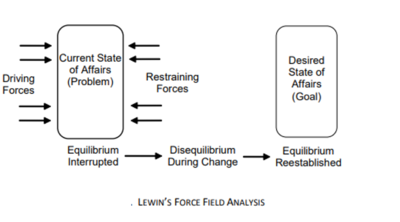Force Field Analysis
In 1951, Lewin developed a model for analyzing and managing organizational problems which he has termed Force Field Analysis (French & Bell, 1999; Fuqua & Kurpius, 1993; Lewin, 1951). This model is relatively simple to understand and easy to visualize. A depiction of the model (see Figure below) identifies both driving forces and restraining forces within an organization. These driving forces, such as environmental factors push for change within the organization while the restraining forces, such as organizational factors (e.g., limited resources or poor morale), act as barriers to change. To understand the problem within the organization, the driving forces and restraining forces are first identified and, hence, defined. Goals and strategies for moving the equilibrium of the organization toward the desired direction can then be planned.
The model relies upon the change process, with the social implications built into the model (e.g., disequilibrium is expected to occur until equilibrium is reestablished). The general goal of this model is to intentionally move to a desirable state of equilibrium by adding driving forces, where important, and eliminating restraining forces, where appropriate. These changes are thought to occur simultaneously within the dynamic organization.[1]
History of Force Field Analysis[2]
Lewin, a social psychologist, believed the "field" to be a Gestalt psychological environment existing in an individual's (or in the collective group) mind at a certain point in time that can be mathematically described in a topological constellation of constructs. The "field" is very dynamic, changing with time and experience. When fully constructed, an individual's "field" (Lewin used the term "life space") describes that person's motives, values, needs, moods, goals, anxieties, and ideals.
Lewin believed that changes of an individual's "life space" depend upon that individual's internalization of external stimuli (from the physical and social world) into the "life space". Although Lewin did not use the word "experiential" (see experiential learning), he nonetheless believed that interaction (experience) of the "life space" with "external stimuli" (at what he calls the "boundary zone") were important for development (or regression). For Lewin, development (or regression) of an individual occurs when their "life space" has a "boundary zone" experience with external stimuli. Note, it is not merely the experience that causes change in the "life space", but the acceptance (internalization) of external stimuli.
Lewin took these same principles and applied them to the analysis of group conflict, learning, adolescence, hatred, morale, German society, etc. This approach allowed him to break down common misconceptions of these social phenomena, and to determine their basic elemental constructs. He used theory, mathematics, and common sense to define a force field, and hence to determine the causes of human and group behavior.
Force Field Analysis Steps[3]
The analysis is best carried out in small groups of 5 to 9 people who are directly involved in the change implementation process. It is important that everyone else who is also likely to be affected by the change is kept in the loop. To gain their commitment and support for the deployment of the project, they should be kept informed about and involved in planning, development and decision-making from the very beginning. For a more productive discussion, have a force field analysis worksheet ready at the beginning of the meeting. The worksheet can be paper-based or electronic (see template below). Simply add the email addresses of the other group members to the document to give them edit/review access. This way everyone can collaborate on populating the worksheet.
Step 1: Assess the current situation You need to start the session by discussing the current situation of the organization in terms of the issue at hand with the key stakeholders.
This may include determining where you are at, the challenges you are facing due to the issue you are trying to solve, the reaction of the employees, etc.
It’s also important to clarify where you want to go or the desired state you want to achieve with the initiative. At the same time, consider what will take place if you fail to take action to change the current situation.
Here you can do a quick SWOT analysis to understand what strengths you can use to overcome the existing threats and see how you can work on overcoming weaknesses and take advantage of the presented opportunities.
Advantages and Disadvantages of Force Field Analysis[4]
Advantages of Force Field Analysis (FFA)
Some of the advantages of using a FFA are:
- It examines the whole situation
- The analysis is clear to understand
- It shows the risk of any change
- Everyone can be involved in determining strengths and weaknesses
- Helps with decision making
Disadvantages of Force Field Analysis (FFA)
Some of the disadvantages of using a FFA are:
- Subjective to peoples scoring system
- It takes time to develop
- No the best over overly complicated situations with lots of variables

